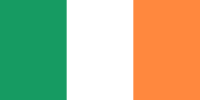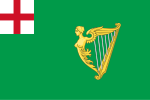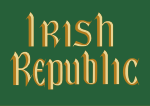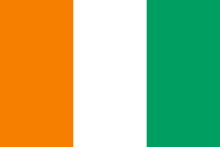Flag of ireland
| Flag of ireland | |
|---|---|
 |
|
| Vexillological symbol : |
|
| Aspect ratio: | 1: 2 |
| Officially accepted: | December 29, 1937 |
The flag of the Republic of Ireland stands as a vertical tricolor in the tradition of the flag of France .
Description and meaning
The national flag has vertical green, white and orange stripes.
| system | green | White | orange |
|---|---|---|---|
| Pantone | 347 | safe | 151 |
| CMYK | 100-0-86-3 | 0-0-0-0 | 0-48-95-0 |
| RGB | 0-149-67 | 255-255-255 | 255-121-0 |
| Hexadecimal color definition | # 009543 | #FFFFFF | # FF7900 |
Again and again you can see Irish flags with a rather yellowish stripe. Sometimes this arises from misinterpreting the stripe as gold , but this variant is also the official flag of County Offaly .
There are no official meanings assigned to colors, but there are many unofficial explanations. Green should stand for the island and the Catholic population , orange for the Protestant population and white for peace between these two denominations . Others see the old Celtic tradition in green and orange stands for the supporters of William of Orange . White would stand for the armistice between the two parties.
It is historically correct that green had a long tradition as the color of the Irish freedom fighters and orange is the color of the Protestants of Ulster, which is derived from William of Orange. It is intended to commemorate the Battle of the Boyne in 1690, in which the Protestant Wilhelm defeated the Catholic James II .
history
In 1782 the Irish Parliament was given the right to represent the country by the British. The symbol of Ireland was the St. Patrick's Cross, a red St. Andrew 's Cross on a white background. After the Act of Union 1800 , which incorporated Ireland into the United Kingdom , the St. Patrick's Cross became part of the British Union Jack . It was a national symbol that the Irish were also allowed to officially use during British rule.
The harp has been an Irish national symbol since the 15th century . The green flag with it was derived from the coat of arms of the province of Leinster . The Society of United Irishmen began using them in the late 18th century. It was also used by the Irish in the 1798 and 1803 uprisings. Today she finds herself as a jack of the Irish Navy.
 ? St. Patrick's Cross
? St. Patrick's Cross
 ? The flag of Leinster
? The flag of Leinster
 ? Erin-Go-Bragh flag
? Erin-Go-Bragh flag
From the 17th century to the early 20th century, the Green Ensign was used on Irish merchant ships , a green flag with the golden harp and, over the years, either the St. Patrick's Cross, the George Cross and finally the Union in the jack Jack.
Following the example of the French tricolor , Irish freedom fighters first used the Irish tricolor in the 19th century. The oldest known representation of the color combination is an emblem from September 1830. At that time, cockades in the three colors were worn at a meeting to celebrate the French Revolution of 1830 , with which the French tricolor was reintroduced as the national flag of France.
The oldest known Irish tricolor flag dates back to 1848 when it was introduced by the Young Ireland movement . One of their leaders, Thomas Francis Meagher , first introduced them to the public at a meeting in Waterford on March 7, 1848. On April 15th it was presented again in Dublin . The order of the colors and shape of the flag was not specified. Sometimes there are also tricolors with the orange stripe on the mast. In the following years until 1916 the tricolor was hardly used. The golden harp on a green background again dominated, which was officially tolerated by the British around 1880. At the Olympic Intermediate Games in Athens in 1906 , the long jump winner Peter O'Connor, who started for the British team, protested that the Union Jack should be set for him. Instead, the green harp flag was used for the award ceremony.
In 1913 two striking workers were killed by police during a demonstration in Dublin. As a result, a paramilitary organization, the Irish Citizen Army (ICA) , was founded by unions . The armed and uniformed units were supposed to protect the workers. In 1914, according to their uniforms, they adopted a blue flag with the constellation of the Big Dipper , also known as the plow . Accordingly, the flag of the Starry Plow ( English: "Starry Plow") was called. The original flag was captured by British troops during the 1916 Easter Rising and was not returned to Ireland until 1966. Today it is in the National Museum in Dublin. In 1934, the Irish Transport and General Workers' Union introduced a simplified light blue version that was widely used by all trade unions, socialist groups and the Irish Labor Party . She used them until the 1970s when they changed the background color to red. In the late 1980s, the plow flag was replaced by a white flag with a red rose. Republican paramilitary groups also used the blue plow flag.
During the Easter Rising from the flag blew main post office ( General Post Office ) in Dublin, but even here the green harp flag with the words "Irish Republic" was used in golden letters in the first place. After the suppression of the uprising, the republican separatists of Sinn Féin in particular used the tricolor, in contrast to the Irish Parliamentary Party , which propagated the green flag and the Home Rule . The tricolor was increasingly perceived as the Irish national flag, but also as the flag of Sinn Féin. With their nationwide victory in the 1918 elections, the green flag was finally pushed into second place behind the tricolor. However, it only retained unofficial status during the Irish Free State period (1922-1937). The 1922 constitution makes no mention of national symbols. It was only with the proclamation of the republic in 1937 that today's tricolor received its status as the national flag.
 ? Green Ensign 1701
? Green Ensign 1701
 ? Proclamation flag of the Irish Republic, 1916
? Proclamation flag of the Irish Republic, 1916
 ? Green Ensign by 1922
? Green Ensign by 1922
 ? Starry Plow 1934
? Starry Plow 1934
More flags of Ireland
The Brian Boru harp is kept in Trinity College in Dublin . It is the model for all modern representations, both in the coat of arms of Ireland , as well as on the presidential standard and the jack of the Irish Navy, this symbol can also be found in the flag of Dublin.
The flag of the four provinces shows the four coat of arms banners of the Irish provinces. The flag itself has no official status, but is often used as an alternative to the national flag, for example on various sporting occasions.
Miscellaneous
The Ivory Coast uses the same tricolor as its national flag , but with the orange stripe on the side of the pole and in different proportions.
There is a cocktail called the Irish Flag . It consists in equal parts of peppermint liqueur (green), Irish cream (white) and Grand Marnier (orange). The ingredients are slowly poured into the glass one after the other along a long spoon so that they do not mix.
Individual evidence
- ↑ Flags of the World - Ireland: county colors of Leinster
- ↑ Gerard Anthony Hayes-McCoy (1979). A History of Irish flags from Earliest Times . Academy Press, Dublin. ISBN 978-0-906187-01-2 .
- ↑ Le Drapeau Irlandais ( French )
literature
- Smith / Neubecker: Coats of arms and flags of all nations, Munich 1980, ISBN 3-87045-183-1
- The National Flag: The History of The Flag, Department of the Taoiseach. ISBN 0-7076-9101-X .














